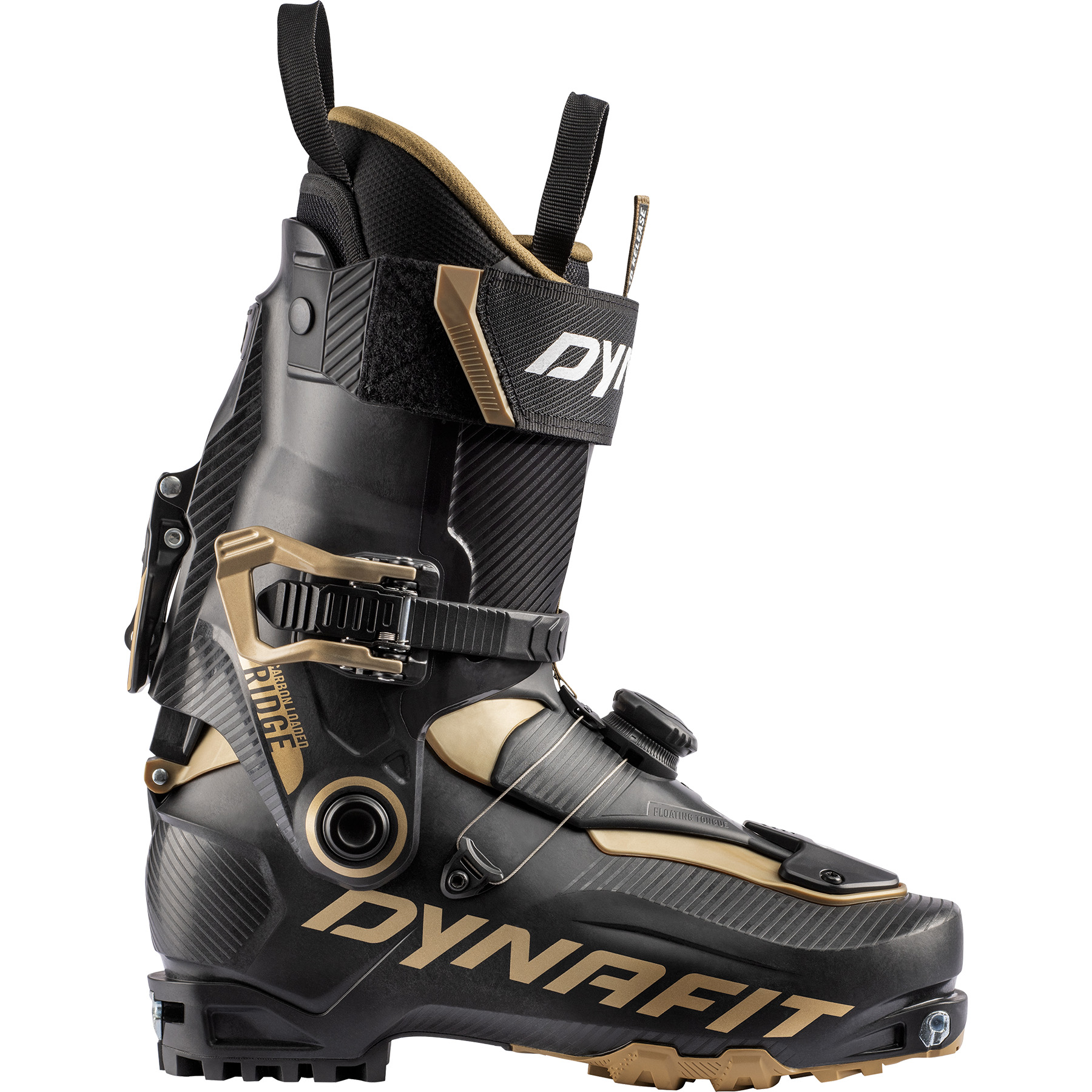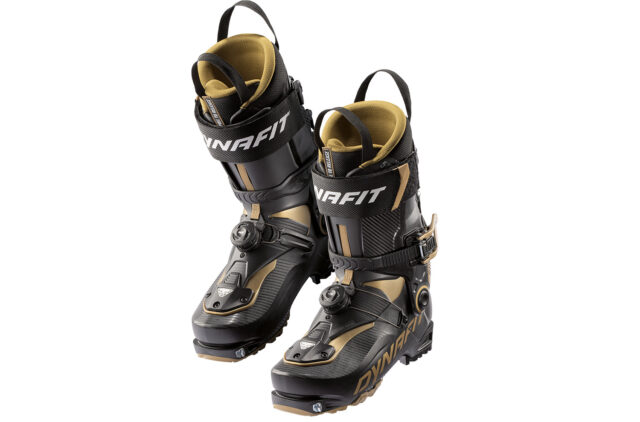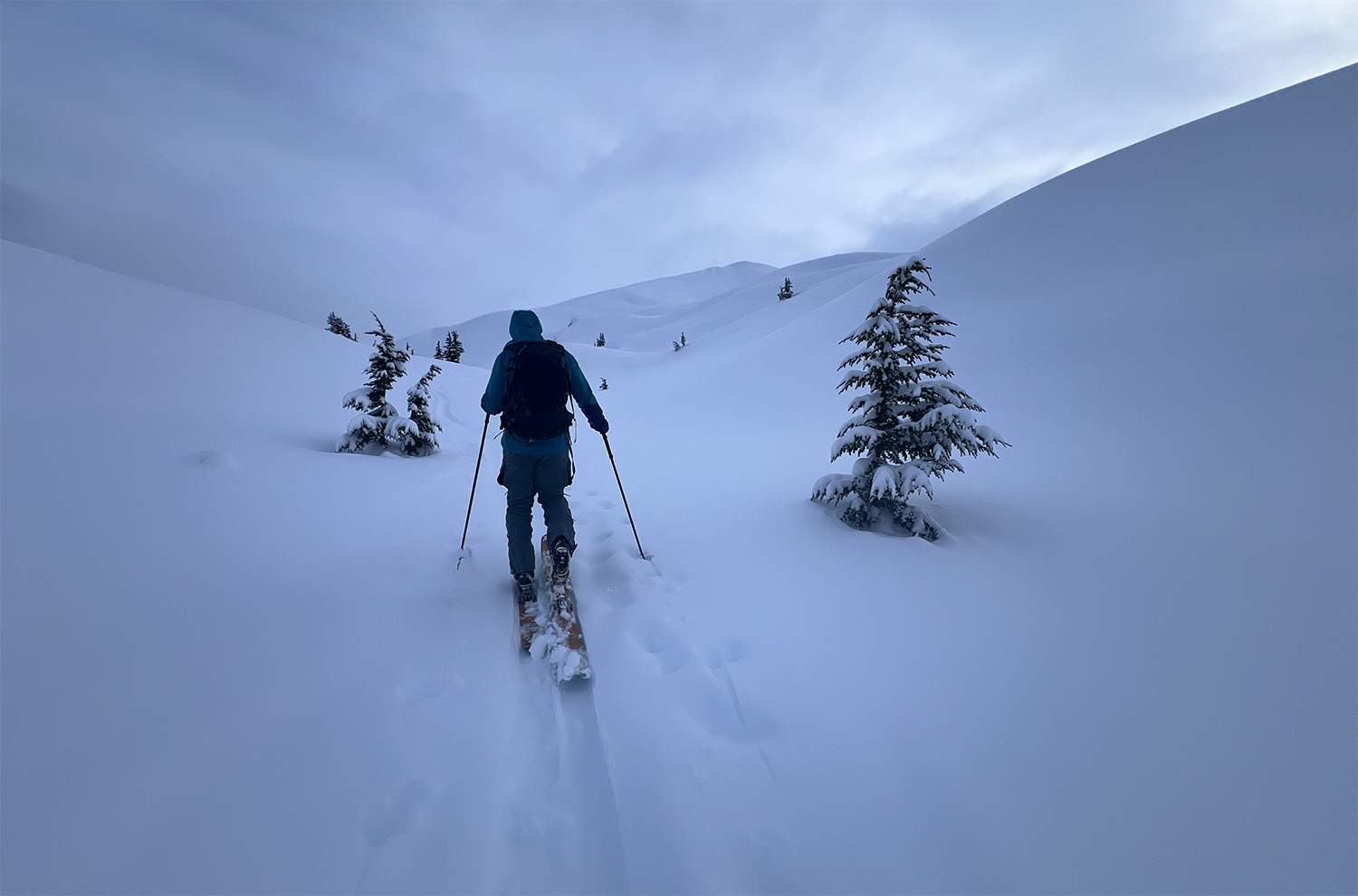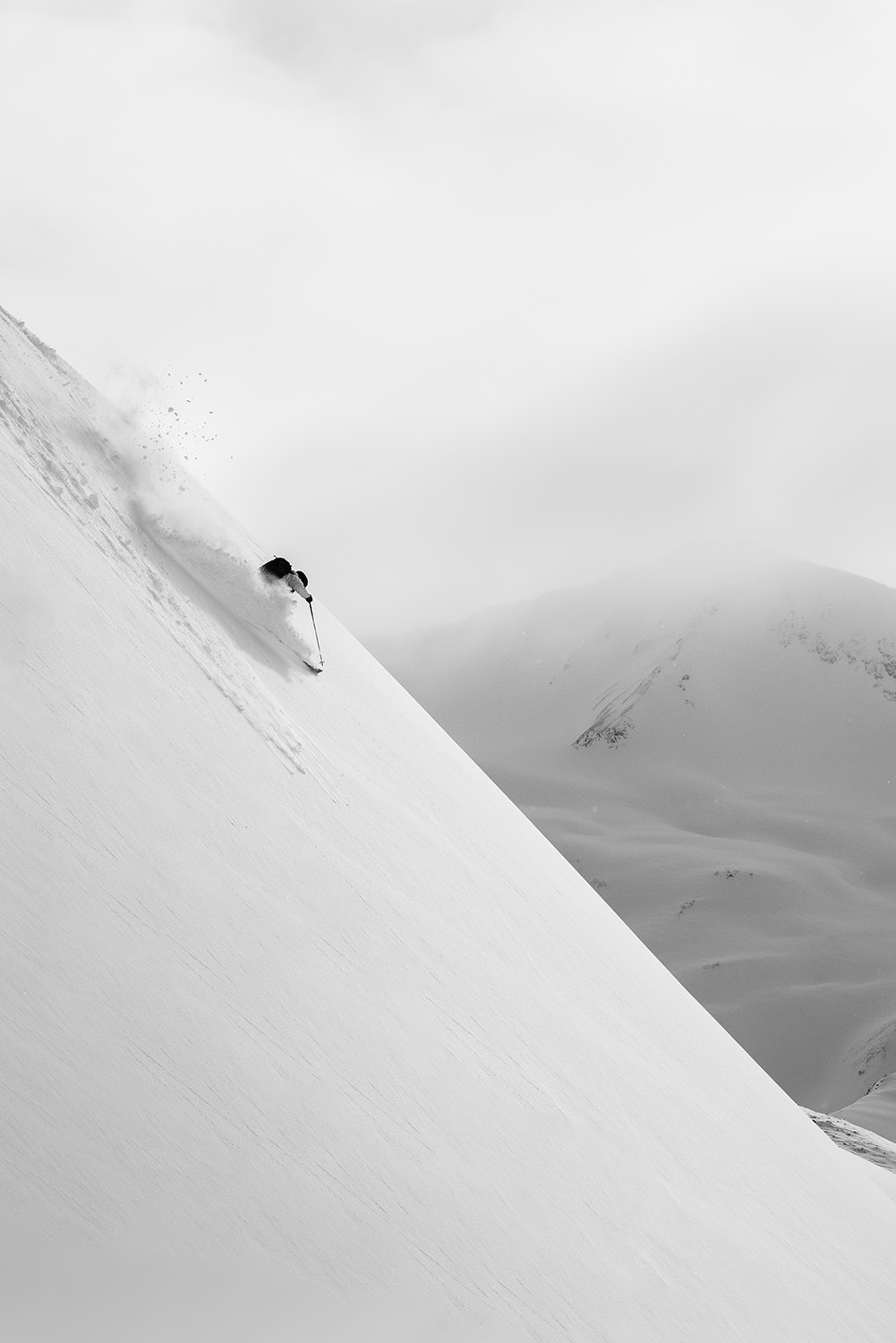Boot: 2025-2026 Dynafit Ridge Pro
Test Locations: Chugach Mountains, Alaska
Test Duration: ~10 days
Stated Flex: 120
Available Sizes: 25–30.5
Stated Last Width (size 26.5): 101 mm
Stated Range of Motion: 70°
Size Tested: 27.5
Blister’s Measured Weight (size 27.5):
- Shells, no Liners: L: 1132 & R: 1135 g
- Liners, no Footbeds: L: 217 g & R: 212 g
- Shells + Liners = 1349 & 1347 g
Additional Specs
Shell Materials:
- Cuff: Grilamid loaded with carbon fibers
- Lower Shell / Shoe: Grilamid loaded with carbon fibers
Stated Forward Lean: 12° (adjustable to 15°)
Soles: full-length Vibram rubber
Binding Compatibility: pin / tech bindings only
Tech Fittings: Dynafit Master Step

Intro
The Dynafit Ridge Pro launched in the 2024-2025 season, and it was developed with significant input from Eric ‘Hoji’ Hjorleifson. I first saw Hoji skiing in them at the 2023 Blister Summit, though at the time, he was keeping them hidden under neoprene boot covers.
It wasn’t clear exactly what he was testing, but, knowing my penchant for lightweight boots, he told me that it was something special that I’d appreciate. I eventually got a chance to try it myself, and I’ve now been able to test this lightweight but still descent-focused boot over the course of a full season to see where it falls in today’s ever-evolving touring-boot market.

The Dynafit Ridge Boot Series
Dynafit currently offers four Ridge boot models — two men’s models and two women’s versions. They all share the same core features, but they vary in stiffness, weight, price, and available sizes. The Ridge boots were introduced in the 24/25 season and carry over into the 25/26 season.
For reference, here’s the quick breakdown of the Ridge collection:
Dynafit Ridge Pro (the boot reviewed here)
Stated Flex: 120
Stated Weight per Boot (size 26.5): 1250 grams
Measured Weight per Boot (size 27.5): 1348 grams
Available Sizes: 25–30.5
MSRP: $899.95
Dynafit Ridge
Stated Flex: 110
Stated Weight per Boot (size 26.5): 1280 grams
Available Sizes: 25–30.5
MSRP: $799.95
Dynafit Ridge Pro W
Stated Flex: 110
Stated Weight per Boot (size 24.5): 1130 grams
Available Sizes: 23–27.5
MSRP: $899.95
Dynafit Ridge W
Stated Flex: 100
Stated Weight per Boot (size 24.5): 1150 grams
Available Sizes: 23–27.5
MSRP: $799.95
Design and Features
At a broad level, the Ridge is a 3-piece boot with a lower shell, partially overlapping upper cuff, and a jointed, “floating” plastic tongue. It features a wide (50 mm) velcro-style power strap up top, a lower cuff buckle that tensions a ratchet-style strap at the bottom of the cuff, and a minimalist MOZ dial and cable system to secure the lower shell.
When tensioned, the ratcheting buckle on the cuff pulls the boot’s plastic tongue back toward the ankle pocket, effectively decreasing the instep height (this is why Dynafit calls it a “floating” tongue). In uphill / walk mode, if you loosen the cuff buckle, the tongue can slide fore and aft for added range of motion.

As for materials, the Ridge Pro’s shell and cuff are made of Grilamid that’s “loaded” with carbon fibers for reinforcement.
The Ridge features the latest version of Eric Hjorleifson’s signature “Hoji Lock” mechanism, but it has been updated. Its core functionality remains quite similar — locking the mechanism into ski mode interlocks the upper cuff and low shell across a broad area, rather than a single spot on the spine (as is common with most touring boots). Flipping the Hoji Lock into walk mode not only disconnects the upper cuff from the lower shell, it also simultaneously loosens the boot’s upper power strap, which has the potential to eliminate a step from the transition process.
This system operates more smoothly in the Ridge Pro than some earlier boots that featured previous iterations of the Hoji Lock platform (e.g., the original Dynafit Hoji and Hoji Free 130). Transitions between walk and ski mode require less fiddling with buckles, which is an improvement over earlier Hoji Lock boots, at least for my foot / leg shape. I’ll touch more on this below.

The Ridge’s dial-and-cable lower closure is fairly common on lighter touring boots these days. I typically like these sorts of closures for their ability to fine-tune fit, but because of the instep pressure issue I have with the Ridge (more on that in a second), I typically found myself loosening it rather than using it to adjust volume. For those who don’t experience the same fit problem, the dial system could provide better control over forefoot hold.
Another noteworthy feature on the Ridge is Dynafit’s “Master Step” tech fittings. These worked seamlessly with every tech / pin binding I tested, including several from Marker, Dynafit, and ATK. I never experienced frustration getting into bindings, even in deep snow or tricky conditions. While this might not seem like a big deal, it’s nice to have a reliable and consistently easy step-in experience, especially when transitioning quickly in deep or punchy snow.
Lastly, the Ridge features a full-length, rockered Vibram rubber sole, and it has very short toe and heel welts that do not fit an ISO norm for alpine bindings. I.e., the Ridge is only intended to be used with pin / tech bindings.
Fit
Fit is always highly subjective, and what works (or doesn’t work) for one person may be completely different for someone else. This is why we strongly recommend that everyone buy their boots from a trusted local shop; they can tell you which boots make sense for your feet and make any necessary fit adjustments. If you don’t know which shops to go to, check out our full list of Blister Recommended Shops.
For me, the instep height was the biggest limitation of the Ridge Pro’s fit, and I suspect that this will be the deciding factor for some other skiers. Now, I have a fairly high instep and have had issues with low-instep boots in the past, but this one was particularly problematic — almost unskiable without some modifications. I tried molding the liner, removing the footbed, and swapping liners, but I couldn’t get it to feel comfortable. Even when I tried a larger size, the instep still felt too low for my foot shape. This reminded me of the fit issues I had with the original Hoji Free 130, though this might be a non-issue if you, unlike me, rarely struggle with boots’ instep heights being too low.
Instep aside, the Ridge’s toe box provides adequate space for my feet, and the heel / ankle feels medium in volume — not as locked-in as the Tecnica Zero G Tour Pro, but not particularly loose, either.
With a stated last width of 101 mm (for a size 26.5), the Ridge Pro’s width feels comparable to most other “medium-volume” boots, but it’s roomier overall (except for instep height) than some low-volume boots like the Zero G Tour Pro.
I never really got comfortable in these boots, despite a lot of work — which is a bummer, since I think the performance of the Ridge Pro is quite impressive (more on that in a moment). But even the very thinnest insoles I could find left me with too much instep pressure; I ended up just skiing them with no insole, which I also don’t like very much. This was all after heat molding the liners with lots of foam on top of my instep to create more room, but it just wasn’t enough. For reference, while the instep is a frequent issue for me, I can still ski some other boots with a notoriously low instep, including the Scarpa Quattro series (in my normal size). Something about the Ridge just really didn’t work for my feet. The medium-volume fit around the heel and ankle just added to my troubles, making the boot feel loose in the places I wanted it to feel tight.
Obviously, I don’t have your feet, and I’m sure there are plenty of folks who will be able to achieve a good fit in the Ridge Pro. But skiers with higher insteps should expect significant boot work or look elsewhere.
FULL REVIEW
Uphill Performance
The Ridge’s range of motion (aka, ‘ROM’) is excellent, with the advertised 70 degrees of cuff rotation allowing for a smooth and natural stride. Walking efficiency is where the Ridge Pro really sets itself apart in today’s market — it’s quite low friction in tour mode, which makes it comfortable for long approaches or really steep climbs, both of which tend to reveal the limitations of other touring boots’ effective range of motion.

Compared to a benchmark “freeride touring” boot, the Tecnica Zero G Tour Pro, the Ridge Pro feels less restrictive on the ascent. The Zero G Tour Pro is stiffer and generally more downhill-oriented, but it’s one of the best walking boots we’ve used that still offers a very stiff, flex pattern that’s fairly reminiscent of alpine boots. With that context in mind, I think the Ridge Pro walks better than any “130-flex” touring boot we’ve tested.
Overall, if uphill efficiency is a high priority, the Ridge Pro is a strong competitor in its category. It offers tons of usable range of motion, and it’s very quick and easy to transition. At about 1350 grams per boot for our size 27.5, it’s heavier than most other boots that match its effective range of motion, but the Ridge Pro also skis better than the majority of those boots…

Transitions
One of the biggest selling points of the Hoji Lock System has always been its (potential) ability to speed up transitions. With past Hoji boots, such as the Hoji Free 130 and Dynafit Tigard, I never really found this system to work as advertised — I still ended up adjusting buckles and fiddling with the fit during transitions. However, with the Ridge Pro, I was actually able to take advantage of setting the buckles once and leaving them that way, whether I was in uphill or downhill mode (with the Hoji Lock lever serving as the sole way to tighten / loosen the boot). This definitely made transitions faster and easier than with previous models.
That said, I still frequently find myself adjusting the dial-style closure, though it was quick and intuitive to use. The “floating” aspect of the tongue also worked well, which helped make switching modes feel smoother since the tongue could move in walk mode but was snugged down in ski mode.
Overall, the Ridge Pro is an improvement over previous Hoji-Lock boots in terms of transition efficiency, and it’s comparable to some lighter boots (e.g., Tecnica Zero G Peak, Scarpa F1 LT) in this regard. At least for me, the Ridge Pro’s Hoji Lock system doesn’t completely eliminate the need to make minor buckle and fit adjustments. That said, whether you can completely forgo fine-tuning of the Ridge’s closures during transitions may depend on your particular foot and leg shape.
Downhill Performance
Despite its relatively low weight, the Ridge Pro is stiff enough to handle aggressive skiing.
In terms of forward flex stiffness, it feels similar to the Tecnica Zero G Tour Pro, and in rearward support, the Ridge Pro may actually be stiffer.
(I’m going to reference the Zero G Tour Pro fairly often here because I think it’s the current benchmark for uphill and downhill performance in this weight class, and because I spend a lot of days in it.)
So, yes, the Ridge Pro is quite supportive, especially relative to how well it goes uphill. However, the flex pattern of the Ridge Pro is highly progressive, meaning its resistance ramps up quickly as you flex the boot more, rather than doing so gradually. Unlike the Zero G Tour Pro, which allows for deeper flex before hitting its stiff point, the Ridge Pro stiffens abruptly — more like the “hitting a wall” sensation that’s common in lighter boots. For reference, the Zero G Tour Pro’s flex pattern also feels quite progressive and fairly abrupt in how it ramps up — if you’re comparing it to the flex pattern of a far heavier, fixed-cuff alpine boot — but the ramp-up takes place just a little later in the flex.

Compared to the best 2-buckle, ~1000-gram boots I’ve used (e.g., Scarpa F1 LT & Tecnica Zero G Peak Carbon), the Ridge Pro feels more powerful in every direction. Compared to softer 2-buckle boots like the Dalbello Quantum Evo, the Ridge Pro is dramatically more powerful. And when compared to some boots marketed in a similar way to the Ridge Pro, such as the Head Crux Pro or the Dalbello Quantum Free Pro, the Ridge Pro is also significantly more powerful in every direction. I.e., I’d position the Ridge Pro’s flex pattern closer to the “freeride touring” category of boots than the more uphill-oriented group of boots in the ~1000-1300 gram range.
Now, I mostly tour to find soft snow, where I rely more on the snow for suspension than my boots. In those cases, the Ridge Pro felt supportive and predictable. However, on firm and bumpy conditions, it feels less forgiving and a bit more ‘harsh’ than the Zero G Tour Pro (which provides a more gradual flex ramp-up, creating a smoother ride quality). The Ridge Pro still has enough support to handle variable conditions and terrain, but it transmits more impacts to the skier, making it less comfortable on rougher snow.
I skied the Ridge Pro with a wide variety of skis, ranging from 100 mm underfoot all the way up to 138 mm. One of the most noticeable aspects of this boot is its lateral power — it provides plenty of control, even when paired with wider, more demanding skis. Despite weighing over 200 pounds myself and typically carrying a 25-pound pack (including an airbag and camera gear), I never felt like the boot was underpowered or struggling to drive the ski.
For my purposes, the Ridge Pro felt most at home with skis in the 110-120 mm width range and in soft snow conditions. Even if I didn’t factor in the fact that the Ridge isn’t compatible with alpine bindings (pin / tech bindings only), it would still be far from my top choice for a touring boot that would do double duty as an inbounds setup; I’d go much heavier in that case.
While the Ridge Pro had no problem controlling narrower or wider skis, this mid-fat range seemed to provide the best balance of stability, control, and maneuverability. Skiers looking to use the Ridge Pro for lighter, faster touring setups might find it to feel like overkill, since you have lots of options that weigh a couple hundred grams less per foot. Folks who pair the Ridge Pro with heavy freeride skis should still find enough support, provided that they’re comfortable with the boot’s stiff, highly progressive flex; if you want a boot that feels more like an alpine setup in terms of flex pattern, you’ll probably want to bump up to a heavier boot (e.g., Tecnica Zero G Tour Pro, Scarpa 4-Quattro Pro, Lange XT3 Tour 130, etc.).
Who’s It For?
The Ridge Pro will work best for skiers who prioritize uphill efficiency but still want a powerful flex pattern on the descent. If you have a lower instep, this could be an excellent touring option, particularly if you pair it with mid-fat freeride skis. Its fit will be a limiting factor for some (like me), and its flex pattern isn’t as smooth or forgiving as some heavier alternatives. But the Ridge Pro offers a really impressive combo of uphill efficiency and downhill support.
Bottom Line
The Dynafit Ridge Pro is a lightweight touring boot that walks exceptionally well and still feels quite powerful on the descent. Its fit may be polarizing, and skiers with high insteps could struggle in that regard. But if it works for your feet, the Ridge Pro offers quite strong fore, aft, and lateral power transfer, excellent uphill mobility, and quick transitions — making it capable of handling a variety of skis and backcountry terrain.



My wife and I both skied the Ridge Pros all winter. I have a low instep and she has a very high instep. We both have narrow heels. Her forefoot is pretty average and mine is I slightly wider than average. The boots fit both of our feet with no issues and only mold of liners. My wife has to be careful not to over tighten the power strap, but that’s been the only issue. I agree with Paul that the last width is medium and we both have a little room, but not too much, and I kinda like a little room ion touring boots. For reference, I ski a Lange LV boot for my resort boot. We absolutely loved these boots for both uphilling in the resort and touring. I skied them with 96mm and 120mm skis in lots of conditions, including skiing hard in the resort on uphill days. Plenty of power and ROM is amazing. I can’t recommend these boots enough. For us, they are a rare quiver killer product. All of our other touring boots are retired or sold.
In size 30 I found these boots to have the widest midfoot and forefoot of any that I’ve tried. Hurray! Alas, the instep buckle/tension, whilst pleasantly low, I found to be located particularly far forward on the foot. Combining this with a generous heel pocket and cavernous ankle area led to a lack of internal support which I couldn’t imagine fixing.
Also worth mentioning of the walk mode: I found the ROM biased rearward, which I actually quite like. But good forward range was only accomplished by completely undoing the middle/ankle buckle, leaving the cuff wide open. While this is “ok”, I find it dramatically inferior to a closed cuff for serious walking endeavors. On tongueless boots like the Peak, Summit, Quantum, XTD, F1, etc, you can have the cuff buckle closed or even tight without majorly compromising walkability. Connecting the lower leg to the walk in this way (as opposed to balancing on the foot with the leg free in a lose cuff) is massive for efficiency, reducing huge amounts of ankle/knee/hip stabilization work. It also adds mega security when sidehilling and down-skinning. The Ridge Pro is a lightweight boot which foregoes this efficiency-win entirely in favour of having that plastic across the external throat. Crazy or genius ha? Something for everyone.
I’m curious if the non-carbon infused (not Pro) Ridge has a flex more comparable to the ZG – less wall like – or if the design just can’t mimic the characteristics of an overlap boot.
Chose the Ridge (non Pro) for that reason. For me the difference was huge but I’m not the biggest skier (75kg/177cm). Felt like the Pro would chop off my leg.
I tried the Dynafit Ridge Pro this winter and was impressed. The floating tongue/lower ratchet is a great solution to getting good tongue to shin pressure.
However I was not impressed enough to forgo my La Sportiva Scorpius V1 that outperforms the Ridge Pro in every dimension except transitions. It still shocks me that a boot that came out many years ago is still out performing so many boots in the 1100-1300g range.
Tried them and had massive shin-bang cause they are strangely low-cut or feel that something shell-related is cutting mid shin,….then the hoji lock Thing is not really working in-field….the transition of e.g. ZGPT is maybe 10 seconds per Boot slower so what?….then the fit: is it just me or cant dynafit boots ever fit to any foot? Got a pretty standard foot with narrow heels, Medium arch medium Volume forefoot and i can at least try painlessly most skiing boots….but i can never EVER ski or walk dynafit boots without fit or pain issues…second that Skorpius Comment, this is probably the most underrated lighter touring boot of all time!….cant wait to try the new light 1200g. la sportivas for 2026
You say Zero G Tour Pro is a low volume boot? No way…